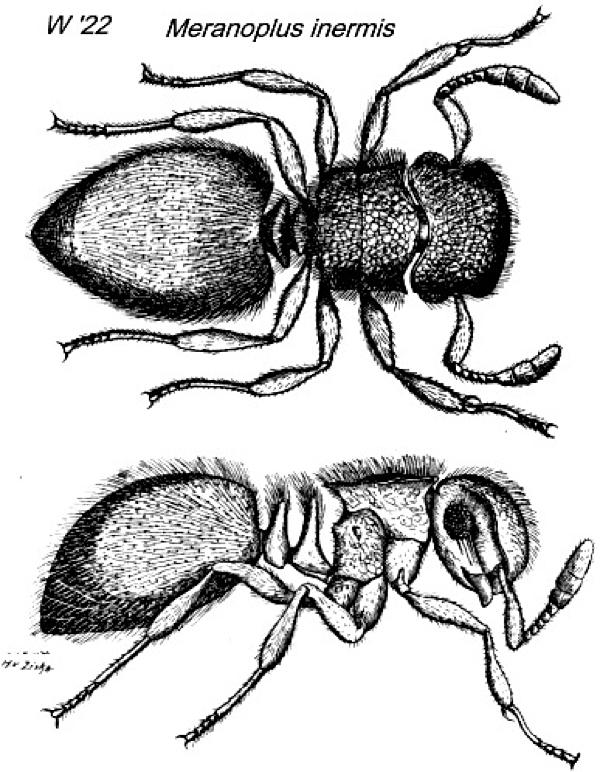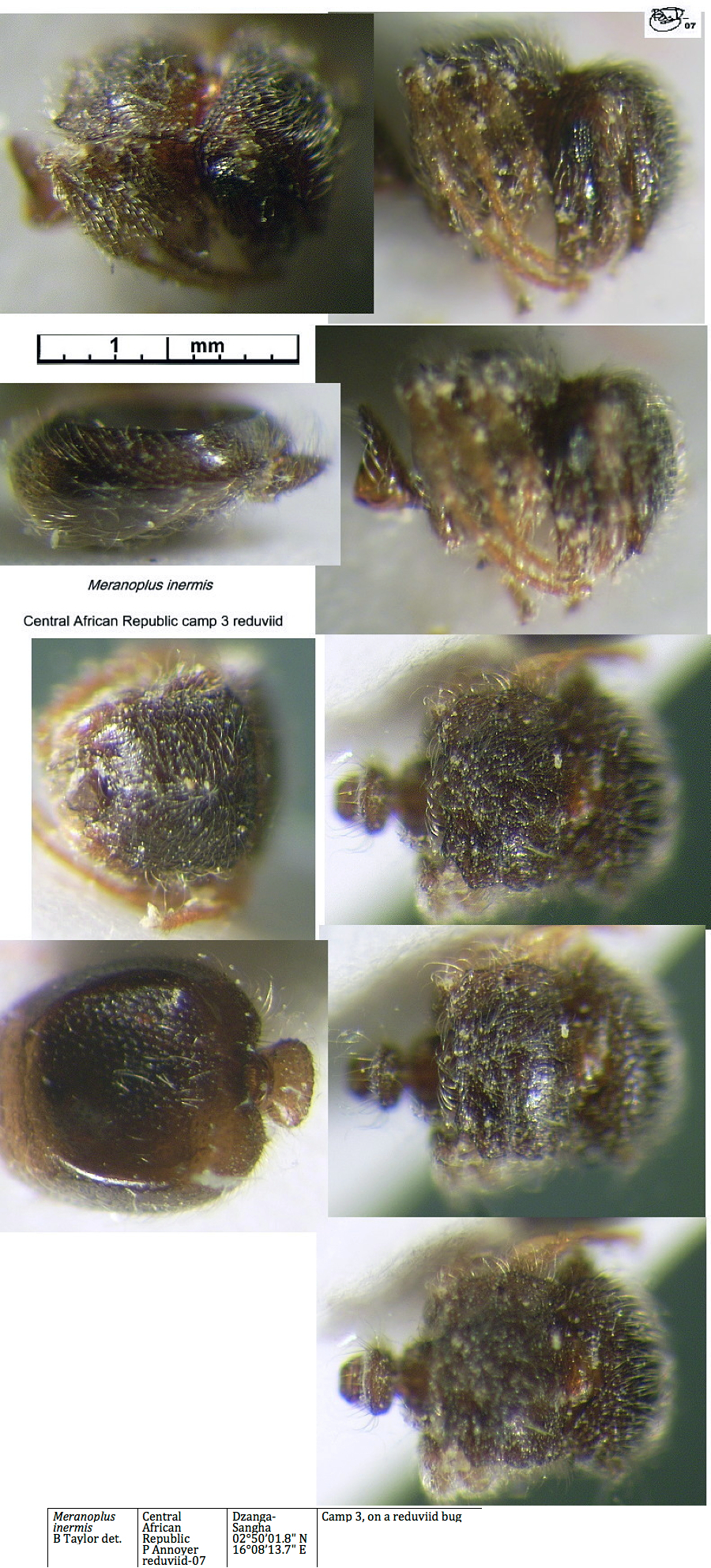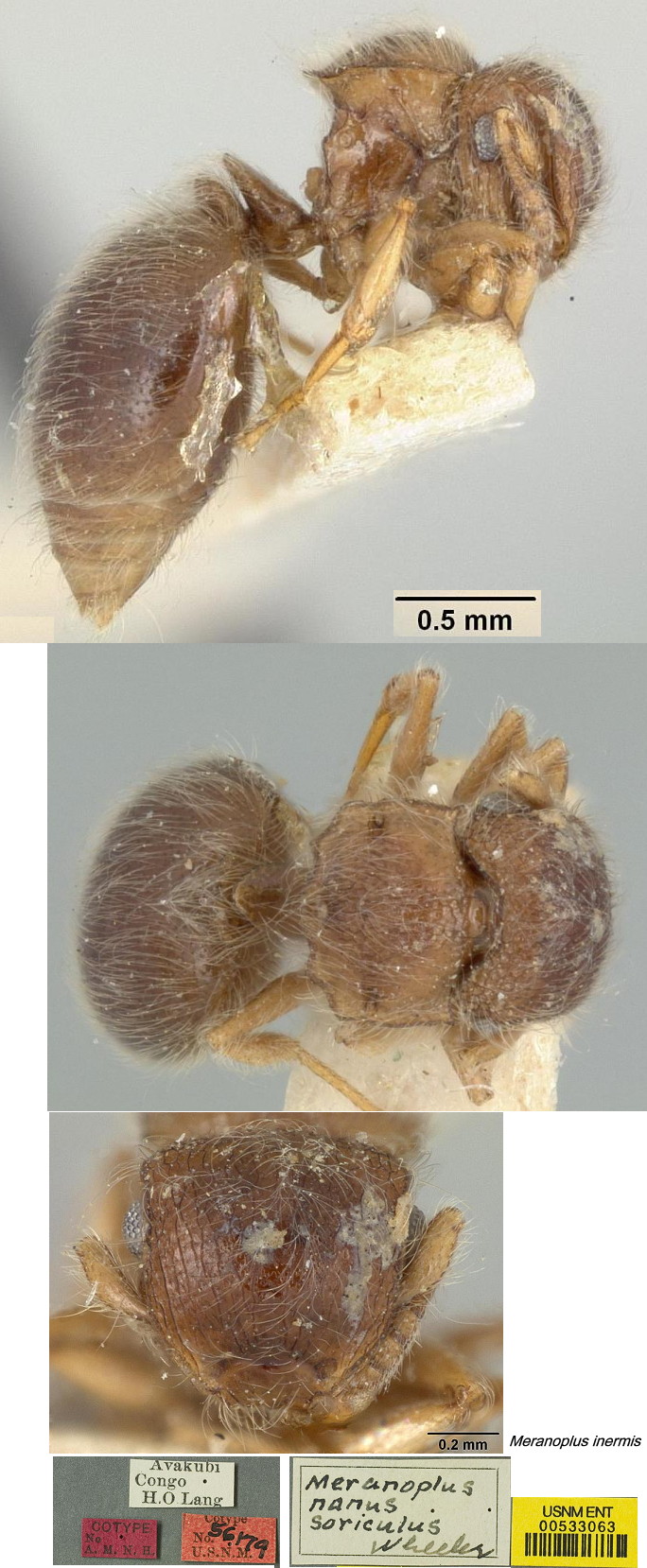Meranoplus inermis Emery
  Type location South
Africa (Meranoplus inermis
n. sp., Emery, 1895h: 41, illustrated, promesonotal shield only
worker) from Makapan Type location South
Africa (Meranoplus inermis
n. sp., Emery, 1895h: 41, illustrated, promesonotal shield only
worker) from Makapan
junior synonyms
affinis (Meranoplus
nanus Ern. André subspec. similis
nova, Karavaiev, 1931d: 44, illustrated, worker; replacement name for
unavailable similis by Baroni Urbani, 1971b: 361) from Kenya,
Mabira
kiboshana (Meranoplus
nanus André var. Kiboshana
n. var., Forel, 1907a: 12, worker) from Kenya, Kibosho, Katona
nanior (Meranoplus
nanus André subsp. nanior
n. subsp., Forel, 1907a: 12, worker; Viehmeyer, 1922:
309, queen)
from Kenya, Mto-ya-kifaru,
Katona
soriculus (Meranoplus
nanus Ern. André subspecies soriculus
new subspecies, Wheeler, 1922: 184,
illustrated, worker & queen) from Zaïre, Akavubi, Lang
& Chapin
(see Bolton, 1995)  . .
|
 Emery's (1895h) description is at Emery's (1895h) description is at  . Arnold (1917: 365) gave a translation,
this is at . Arnold (1917: 365) gave a translation,
this is at  . Forel's (1907a) description of nanior
and kiboshana is at . Forel's (1907a) description of nanior
and kiboshana is at  . Arnold (1917: 366) gave an illustrated
translation of nanior, this is at . Arnold (1917: 366) gave an illustrated
translation of nanior, this is at  . Karavaiev's (1931d) illustrated
description of "similis" is at . Karavaiev's (1931d) illustrated
description of "similis" is at  . Bolton's modern description (1981a) is at . Bolton's modern description (1981a) is at

|
 The
photomontage of the type worker is collated from http://www.antweb.org/specimen.do?name=casent0904681 The
photomontage of the type worker is collated from http://www.antweb.org/specimen.do?name=casent0904681
|
 Nigeria
specimen (Taylor, 1979: 63). WORKER. TL 2.8 mm, HL 0.70, HW 0.72, SL
0.37, PW 0.78 (previously in my guide as Meranoplus nanus). Nigeria
specimen (Taylor, 1979: 63). WORKER. TL 2.8 mm, HL 0.70, HW 0.72, SL
0.37, PW 0.78 (previously in my guide as Meranoplus nanus).
Colour brown. Faint longitudinal, widely spaced rugae on the head and
dorsal promesonotum. Clypeal margin shallowly concave. Posterior margin
of promesonotal shelf with an outer pair of large blunt teeth and an
inner pair of smaller, sharper teeth. Circular spiracle openings
laterally at the junction of the pro- and mesonotum, median circular
light area near the border of the posterior shelf or shield.
Bolton (1981a, illustrated, alitrunk profile and a
range of variations in the promesonotal shield) described it as one of
the two commonest members of the genus in Africa; found nesting in the
ground in wooded or forested areas almost throughout the continent.
Wheeler (1922) illustrated (left) and described the subspecies soriculus
noting that Mr. Lang reported that these ants "build small crater nest
in the plantations", the nest being some 7 cm wide and no more than 15
cm deep.
|
 In Nigeria,
collected from under a rotten banana stem at CRIN (B. Bolton).
Elsewhere in Nigeria at Mokwa (C. Longhurst) and Ile-Ife (J.T. Medler)
(Bolton, 1981a). In Nigeria,
collected from under a rotten banana stem at CRIN (B. Bolton).
Elsewhere in Nigeria at Mokwa (C. Longhurst) and Ile-Ife (J.T. Medler)
(Bolton, 1981a).
In Ghana, Strickland (1948, 1951a) described it
(as M. nanus) as not being found in his quantitative work, but
collected three times at CRIG, twice attending a mixed colony of aphids
and mealybugs (Planococcoides njalensis) on cocoa. Bolton
(1981a) listed findings at Kibi and Asamankese (D. Leston; CRIG (H.E.
Box); and Mampong (P. Room). The last presumably was from those
collected from open ground at the Mampong Cemetery farm (Room, 1971).
Belshaw & Bolton (1994) collected a single specimen from leaf
litter at CRIG, commenting that this was the sole Ghanaian species.
|

Meranoplus inermis variant (previously Meranoplus
species T¹)
Nigeria specimen (Taylor, 1979: 63)TL 2.68 mm, HL
0.73, HW 0.68, SL 0.37, PW 0.70
Very similar to M. inermis but generally longer and slimmer in
dorsal view, also with somewhat longer, finer and more abundant hairs.
Colour dark brown. Posterior margin of promesonotal shelf with a single
pair of moderately large teeth. Promesonotal suture more clearly
marked, lateral spiracle opening incised in the shelf margin. Clypeal
margin near straight.
In Nigeria, I collected it several times tending
aphids on cocoa flowers. Several features seem to separate this from
the other M. inermis, although the description by Bolton
(1981a) has several plastic points, e.g. "Anterior half of clypeus
usually shallowly concave between the carinae" and his comments on
smaller specimens mainly cover the T¹ differences. The key defining
feature of the species is the lack of propodeal spines. Bolton (1981a)
listed one of my specimens as among the inermis findings. From
his full description of inermis it is clear that this variant
has all the characters which he noted for "smaller individuals". The
promesonotal shield, moreover, clearly differs from any of the four
variants which he illustrated.
|
Oxford University Museum
specimens
Meranoplus inermis
B Taylor det. |
Benin
J-F Vayssieres
RVA 2925
|
10.ix.2012
Korobourou
09°22'13'' N
02°40'16'' E
|
Mangifera indica orchard
Quadrat 1, tube 6, variété: Eldon
Ground nesting
|
2
|
 |
Meranoplus inermis
B Taylor det.
|
Cameroun
A Fotso Kuate
Meranoplus inermis
|
9.v.2007
Awae II
03°54'30" N
11°25'58" E
|
Quadrat in fallow
|
1
|
 |
Meranoplus inermis
B Taylor det.
|
Central African
Republic
P Annoyer reduviid-07
|
Dzanga-Sangha
02°50’01.8" N
16°08’13.7" E
|
Camp 3, on a
reduviid bug
|
1
|
 |
|
 The photomontage is of a worker from Benin;
Korobouro; collector J-F Vayessieres (RVA2925). The photomontage is of a worker from Benin;
Korobouro; collector J-F Vayessieres (RVA2925).
|
 The photomontage is of a worker from Cameroun;
Awae II; collector A
Fotso Kuate (FK Meranoplus inermis) The photomontage is of a worker from Cameroun;
Awae II; collector A
Fotso Kuate (FK Meranoplus inermis)
|
 The
photomontage is of a worker from the Central African Republic,
Dzanga-Sangha National Park; collector Philippe
Annoyer (CAR Camp 3). The
photomontage is of a worker from the Central African Republic,
Dzanga-Sangha National Park; collector Philippe
Annoyer (CAR Camp 3).
|
 The photomontage of
a cotype of soriculus is
collated from The Smithsonian Institute images at http://ripley.si.edu/ent/nmnhtypedb/public/specimeninfopage.cfm?publicconsumption=1&typespecimenID=709 The photomontage of
a cotype of soriculus is
collated from The Smithsonian Institute images at http://ripley.si.edu/ent/nmnhtypedb/public/specimeninfopage.cfm?publicconsumption=1&typespecimenID=709
Wheeler's (1922) illustrated description is at  . .
|
 The
photomontage is collated from http://www.antweb.org/specimen.do?name=casent0406910
Collection Information: Specimen Code CASENT0406910; Locality Central
African Republic: Prefecture Sangha-Mbaéré: Parc National Dzanga-Ndoki,
Mabéa Bai, 21.4 km 53° NE Bayanga; 03°02'00"N 016°24'36"E 510 m;
Collection codes: BLF04000; Date: 1-7 May 2001; Collected by:
B.L.Fisher; Method: EC19 sifted litter; Habitat: rainforest; Transect
Type: MW 50; sample transect, 5m;Transect Sample No.: L.O. The
photomontage is collated from http://www.antweb.org/specimen.do?name=casent0406910
Collection Information: Specimen Code CASENT0406910; Locality Central
African Republic: Prefecture Sangha-Mbaéré: Parc National Dzanga-Ndoki,
Mabéa Bai, 21.4 km 53° NE Bayanga; 03°02'00"N 016°24'36"E 510 m;
Collection codes: BLF04000; Date: 1-7 May 2001; Collected by:
B.L.Fisher; Method: EC19 sifted litter; Habitat: rainforest; Transect
Type: MW 50; sample transect, 5m;Transect Sample No.: L.O.
|
|